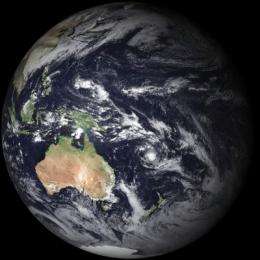Uncertainty of future South Pacific Island rainfall explained

With greenhouse warming, rainfall in the South Pacific islands will depend on two competing effects – an increase due to overall warming and a decrease due to changes in atmospheric water transport – according to a study by an international team of scientists around Matthew Widlansky and Axel Timmermann at the International Pacific Research Center, University of Hawaii at Manoa. In the South Pacific, the study shows, these two effects sometimes cancel each other out, resulting in highly uncertain rainfall projections. Results of the study are published in the 28 October online issue of Nature Climate Change.
The largest rainband in the Southern Hemisphere – the South Pacific Convergence Zone (SPCZ) – is the main source of rainfall for South Pacific island nations. Changes in this rainfall band would have severe consequences for the vulnerable island nations already having to adapt to accelerating sea level rise. Yet, very little is known about how this 8,000-km-long climate feature will respond to greenhouse warming.
"One reason why the SPCZ projections are so elusive is that many climate models are notoriously poor in simulating this important rainband, even under present-day climate conditions," says Postdoctoral Fellow Widlansky at the International Pacific Research Center. "We were able to overcome some model shortcomings in simulating South Pacific climate by removing model deviations from observed sea surface temperatures."
With the resulting improvements in climate model performance, Widlansky, Timmermann, and colleagues could identify two competing mechanisms affecting rainfall trends in the South Pacific.
"We have known for some time that rising tropical temperatures will lead to more water vapor in the atmosphere," explains Timmermann, professor of oceanography at the International Pacific Research Center and the University of Hawaii at Manoa. "Abundant moisture tends to bring about heavier rainfall in regions of converging winds such as the SPCZ." Scientists refer to this as the "wet gets wetter" climate change mechanism.
"Nearly all climate change model simulations, however, suggest the equatorial Pacific will warm faster than the SPCZ region. This uneven warming is likely to pull the rainband away from its normal position, causing drying in the Southwest Pacific and more equatorial rainfall," Timmerman goes on to say. The study refers to this as the "warmest gets wetter" mechanism.
Widlansky adds, "When we evaluated the latest climate change experiments being conducted by international climate modeling groups, we saw that these competing mechanisms are the cause for uncertainty in the SPCZ rainfall projections."
The scientists found that depending upon the degree of tropical warming expected this century, one or the other mechanism is more likely to win out. With moderate warming, weaker sea surface temperature gradients are likely to shift the rainband towards the equator, potentially causing drying during summer for most Southwest Pacific island nations. For much higher warming possible by the end of this century, the net effect of the opposing mechanisms is likely a shift towards more rainfall for the South Pacific islands.
"To be more definite in our projections, however, we need more extensive observations in the South Pacific of how clouds and rainfall form and how they respond to such climate phenomena as El Niño. Before we have more confidence in our calculations of the delicate balance between the two climate change mechanisms, we need to be able to simulate cloud formations more realistically," says Timmermann.
More information: Nature Climate Change. DOI: 10.1038/NCLIMATE1726
Journal information: Nature Climate Change
Provided by University of Hawaii at Manoa


















